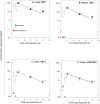Elimination of inhaled 3,3'-dichlorobiphenyl and the formation of the 4-hydroxylated metabolite
- PMID: 23582014
- PMCID: PMC3962796
- DOI: 10.1021/es3049114
Elimination of inhaled 3,3'-dichlorobiphenyl and the formation of the 4-hydroxylated metabolite
Abstract
The recent discovery of 3,3'-dichlorobiphenyl (CB11) as a byproduct of pigment manufacturing underscores the urgency to investigate its biological fate. The high level and ubiquity of atmospheric CB11 indicates that inhalation is the major route of exposure. However, few data on its uptake and elimination exist. A time course study was performed exposing male Sprague-Dawley rats to CB11 via nose-only inhalation with necropsy at 0, 4, and 8 h post exposure. An analytical method for CB11 and monohydroxylated metabolites employing pressurized liquid extraction and gas chromatography-mass spectrometry yielded efficient recovery of CB11 (73 ± 9%) and its metabolite 3,3'-dichlorobiphenyl-4-ol (4-OH-CB11) (82 ± 12%). Each rat was exposed to 106 μg/m(3) vapor-phase CB11 for 2 h and received an estimated dose of 1.8 μg. Rapid apparent first-order elimination of CB11 was found in lung, serum, and liver with half-lives of 1.9, 1.8, and 2.1 h, respectively. 4-OH-CB11 was detected in the liver but not the lung or serum of exposed animals and displayed apparent first-order elimination with a 2.4 h half-life. This study demonstrates rapid metabolism of CB11 and elimination of 4-OH-CB11 and suggests that the metabolite is not retained in the body but is susceptible to further biotransformation.
Figures



References
-
- Venier M, Hung H, Tych W, Hites RA. Temporal Trends of Persistnet Organic Pollutants: A Comparison of Different Time Series Model. Environ Sci Technol. 2012;46:3928–3934. - PubMed
-
- Sun P, Basu I, Blanchard P, Brice KA, Hites RA. Temporal and spatial trends of atmospheric polychlorinated biphenyl concentrations near the great lakes. Environ Sci Technol. 2007;41:1131–1136. - PubMed
-
- Brown JF, Wagner RE. PCB movement, dechlorination, and detoxification in the Acushnet Estuary. Environ Chem. 1990;9:1215–1233.
-
- King TL, Yeats P, Hellou J, Niven S. Tracing the source of 3,3′-dichlorobiphenyl found in samples collected in and around Halifax Harbour. Mar Pollut Bull. 2002;44:590–596. - PubMed
Publication types
MeSH terms
Substances
Grants and funding
LinkOut - more resources
Full Text Sources
Other Literature Sources

